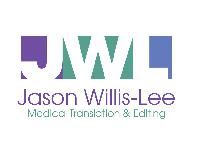The work of the middle man Thread poster: Jason Willis-Lee
|
|---|
Hello folks:
I´m note sure this is the right place for this post but if not I hope it will be moved to the most appropriate place. Its based on some thoughts I've had for some time but have only got round to articulating today, how much work should the middle man be expected to do for his cut?
More specifically, I am referring to the many times and today in particular when I have had a run in with a client over "formatting". That's right, all the extra work from a PDF... See more Hello folks:
I´m note sure this is the right place for this post but if not I hope it will be moved to the most appropriate place. Its based on some thoughts I've had for some time but have only got round to articulating today, how much work should the middle man be expected to do for his cut?
More specifically, I am referring to the many times and today in particular when I have had a run in with a client over "formatting". That's right, all the extra work from a PDF document that has originally come from a client completely ignorant as to what this profession entails and who demands and expects a complete service form the middle man. I have often found that the middle man expects translators to deal with all the formatting issues of a document (converting to and from PDF, and impute hundreds of numbers into tables manually, because an optical reader passes a lot of this by if you try and convert to a CAT-friendly format) as well as get all the translation done on time (lets say 15000 words in 3 working days to cut things fine). My view is that the formatting issues are nothing to do with a translator and that the middle man should provide and if necessary pay for this service, thereby allowing the translator to concentrate entirely on optimising the quality of the translation which is the only thing he or she should be concentrating on.
I would be interested in hearing other experiences and opinions on this especially to do with non-CAT friendly formats such as PDF documents with lots of tables (eg. annual accounts from a major bank which has a lot of numbers to be imputed I can tell you).
Jason ▲ Collapse
| | | |
recently, I stopped working for an American agency because they wanted me to deliver the translated documents in the exact format as the originals, even if the work came in as PDF files. I refused and asked to be paid DTP fees for the formatting. I don't think agencies should get away with this kind of behaviour.
Giovanni
[Edited at 2004-05-27 13:37]
| | | | brigidm 
Norway
Local time: 21:58
Norwegian to English
| A positive experience re: formatting | May 27, 2004 |
Being fairly newly-established, I have yet to face the task of reformatting a PDF document - though I have been doing some trial runs to be prepared. However, I recently had a new client who wanted me to translate a document which (for some strange reason) was available in hard copy form only. They faxed it over, I scanned it, and set about formatting into a Word document - for the first time ever - a hairy experience with a deadline hanging over you. I managed to do it, it took much longer than... See more Being fairly newly-established, I have yet to face the task of reformatting a PDF document - though I have been doing some trial runs to be prepared. However, I recently had a new client who wanted me to translate a document which (for some strange reason) was available in hard copy form only. They faxed it over, I scanned it, and set about formatting into a Word document - for the first time ever - a hairy experience with a deadline hanging over you. I managed to do it, it took much longer than I expected, but I took it as a challenge and learning experience. When I delivered the translated document (right on the deadline and totally exhausted), I sent a cover letter with some comments, and pointed out how much work was involved in this and that in future the client should be aware that he may expect to be charged for such work (but I didn't charge her). She responded by saying that of course I should bill her for this in addition. A week later, the same client asked me to do exactly the same again - fax, scan, re-format, then (finally) the fun bit! This time I had no qualms about charging her for the extra hours involved (and this time there were a number of tables and figures involved), because the client was already "educated" about the extra work involved, and was therefore prepared for this extra cost.
Lesson learned: be upfront with the client - they often have NO IDEA of the technicalities - neither are they really interested. But I shall continue to warn the client BEFORE any such jobs that such work will cost extra, thereby minimalising the risk of misunderstanding/arguments later on down the line. I realise that not all clients will be as ready to listen, but what it comes down to is trying to educate them. Just because they're under pressure doesn't mean that I should suffer the consequences - neither in the form of time nor remuneration for the extra work involved.
[Edited at 2004-05-27 13:28] ▲ Collapse
| | | | Andrew Wille (X)
Local time: 05:58
Japanese to English
| Crazy text boxes | May 27, 2004 |
Yes, this is a big a problem - and one I find completely infuriating. The other day I had a powerpoint translation with tables that were in fact huge assemblies of tiny text boxes - like maybe two hundred on a single slide. Why anyone would want to make a table this way I have no idea, and as to how they hoped to present this to anyone is beyond me. It was a complete nightmare to handle as a translator. You have to draw the line somewhere about how much fiddling around you are willing to do!... See more Yes, this is a big a problem - and one I find completely infuriating. The other day I had a powerpoint translation with tables that were in fact huge assemblies of tiny text boxes - like maybe two hundred on a single slide. Why anyone would want to make a table this way I have no idea, and as to how they hoped to present this to anyone is beyond me. It was a complete nightmare to handle as a translator. You have to draw the line somewhere about how much fiddling around you are willing to do!
Setting that aside, however, I feel that there are circumstances where it is upto the translator to choose the best translation in consideration of the space available. Most of the clients I deal with want their spreadsheets and presentations to be of roughly the same size, style, and legibility as the source files. Add to this the constant problem faced by Japanese to English translators that the same English sentence tends to be much longer than Japanese source and things can get messy.
I think for any page there is a maximised situation where you have both a good layout and a good translation. It is the translator who understands the latter the best, so it kind of comes down to the translator to play about with the layout a bit. I regard my job as both making a document understandable and presentable to the target audience. BUT I draw the line way before juggling, resizing, formatting hundreds of text boxes. ▲ Collapse
| | |
|
|
|
Andy Watkinson 
Spain
Local time: 21:58
Member
Catalan to English
+ ...
| Minimum formatting | May 27, 2004 |
Interesting topic, Jason.
"allowing the translator to concentrate entirely on optimising the quality of the translation which is the only thing he or she should be concentrating on"
I couldn't agree more.
There are obviously several different ways of approaching this.
Some translators may prefer to handle all the formatting work themselves, but naturally at a higher rate in accordance with the effort and time incurred.
Perhaps bec... See more Interesting topic, Jason.
"allowing the translator to concentrate entirely on optimising the quality of the translation which is the only thing he or she should be concentrating on"
I couldn't agree more.
There are obviously several different ways of approaching this.
Some translators may prefer to handle all the formatting work themselves, but naturally at a higher rate in accordance with the effort and time incurred.
Perhaps because I started translating with a borrowed Olivetti Lettera 23(?) typewriter, and no translator could possibly be expected to reproduce the original format (and also because I'm "technologically challenged anyway, I confess), I generally reject any text which requires this kind of work or suggest I handle the translation and they look elsewhere for the rest.
Later, when the first computers and word processing applications appeared (anyone remember Wordstar, DisplayWrite?), it became more difficult to reject this type of work, e.g. transcribing thousands of figures in an Annual Report.
Those programmes were unable to count figures, but one solution was to add a character "ç" at the end of each figure. The programme would then recognise the figure+character as a word and count it. (The "ç's" could easily be removed later by searching and replacing with nothing).
Not even this compensated! As a translator, I consider changing fonts, adding pretty colours, and generally messing around with the format a distraction from what I'm being paid for.
Now, the middle man. Why not go back as far as the client?
When this kind of situation arises, I suggest to the client (directly or via the agency) that the client himself arrange for having formatting or entering vast columns of figures be done at his end.
Many of the agencies I've known have nobody available for this kind of work, and I simply point out that they're going to have to pay me considerably more to do a job which others can do better and more cheaply.
You don't retain the services of a chartered accountant just to tot up your restaurant bill, so why pay a professional translator something which their office staff could do (and free for the firm as it's included in their wages) during a slack couple of hours?
Or perhaps I've been doing too many P&L's recently
Saludos,
Andy ▲ Collapse
| | | | | Another positive experience | May 27, 2004 |
The same as Brigid, I had a very positive experience regarding formatting, working for an end customer, which by the way was my first important free lance job.
They requested a quotation for the translation of approx. 85,000 words. They sent me a CD with many folders and files some of them in Word and others in pdf. This was the first time I handled a pdf document and I soon realized that I couldn't do anything to work directly with the original, and these documents were plenty of... See more The same as Brigid, I had a very positive experience regarding formatting, working for an end customer, which by the way was my first important free lance job.
They requested a quotation for the translation of approx. 85,000 words. They sent me a CD with many folders and files some of them in Word and others in pdf. This was the first time I handled a pdf document and I soon realized that I couldn't do anything to work directly with the original, and these documents were plenty of charts and figures.
As soon as I noted this I contacted the customer and told them that I would charge all the formatting at an extra cost (which I calculated per page) and luckily they accepted with no complaint.
As all of you say it is a question of explaining and letting the customer know how much more work than plain translation, their documents imply.
Good translation to everybody,
Marianela ▲ Collapse
| | | | | Translating pdf documents - try to avoid it but is not always possible | May 27, 2004 |
Hi,
I try to avoid translating pdf /hard copy docs but it is not always possible, or I am told after accepting the job.... I am considering a different rate for 'normal' files (electronic files) and hard copy. Anybody any experience with that?
On the other hand you tend not to give a discount for repeats in such docs and sometimes you are lucky and you can do some copying and pasting.
I do not know if it is worth it going through OCR-ing the doc if the original is quite ... See more Hi,
I try to avoid translating pdf /hard copy docs but it is not always possible, or I am told after accepting the job.... I am considering a different rate for 'normal' files (electronic files) and hard copy. Anybody any experience with that?
On the other hand you tend not to give a discount for repeats in such docs and sometimes you are lucky and you can do some copying and pasting.
I do not know if it is worth it going through OCR-ing the doc if the original is quite smudgy - I must confess I have never done it. It would be good if there was a lot of repeated text.
But yes, it does take longer to translate from paper or a pdf file.
I do not mind too much formatting a page lay-out, but adding drawings I do mind. The last (scanned) doc had a lot of drawings, but I only put 'DRAWING' in that space so that the agency or the client could then do the formatting. The words 'drawing' were counted as words of course!
If there are tables with a lot of numbers (but I only had those in contracts, and there are not too many of those in contracts) , I just think: it's all words, and each number is a word - which pays the same as a word I had to really think about, or do research on.
I did one translation where I actually did a few flow diagrams (one flow diagram was one page!) - I learnt a lot about the best method (create a table and then format the cells) but just as well the whole project was a month's work and my pay did not depend on those diagrams. Never again I would say....
Anyway - I also think that formatting should not be included in a standard translation rate per word. ▲ Collapse
| | | | Marc P (X) 
Local time: 21:58
German to English
+ ...
Anjo Sterringa wrote:
I try to avoid translating pdf /hard copy docs but it is not always possible, or I am told after accepting the job.... I am considering a different rate for 'normal' files (electronic files) and hard copy. Anybody any experience with that?
I have levied a surcharge for hard copy for several years now. At the moment, paper or PDFs with non-extractable text cost 10-20% more. Powerpoint and Excel also cost more.
Result: I hardly ever receive paper, and if I did, the first thing I would do would be to increase the surcharge even further. Paper is inconvenient to store, inconvenient to handle, and prevents me using OmegaT, as I do with almost all my work. In the 21st century, I don't see any need for it.
This business of creating PDFs is completely silly. The whole point of PDFs is that they are designed not to be modified. If you create a new file, format it and export to PDF, you haven't "re-created the original format"; you've done all the layouting from scratch. If that's what people want, they should pay for it.
Often, I'm sure, it's innocence on the part of customers, who don't realize the difficulty of "modifying" PDFs, and bone-idleness on the part of agencies who simply pass on whatever lands in their in-box.
Marc
| | |
|
|
|
tazdog (X)
Spain
Local time: 21:58
Spanish to English
+ ...
I agree with the idea of surcharges. I have also decided to start adding a surcharge for difficult formats. I have a couple regular clients (through agencies) who think nothing of sending their fiddly PowerPoint presentations and expect them to come back in exactly the same format. The last one I did had 63 slides, and there was at least one embedded Excel doc. in 58 of them (a few of the slides had 2 or even 3 embedded docs. in the same slide). Apart from the fact that these don't get includ... See more I agree with the idea of surcharges. I have also decided to start adding a surcharge for difficult formats. I have a couple regular clients (through agencies) who think nothing of sending their fiddly PowerPoint presentations and expect them to come back in exactly the same format. The last one I did had 63 slides, and there was at least one embedded Excel doc. in 58 of them (a few of the slides had 2 or even 3 embedded docs. in the same slide). Apart from the fact that these don't get included in the word count, they are a real pain in the neck to deal with and really reduce my output. This one was the straw that broke the camel's back, and I finally told the agency that I wasn't doing any more of these without adding a hefty surcharge. I may lose out on further jobs from these clients, but it's honestly not worth my while to waste so much time on these. If they want me to do the extra work, they can pay for it. ▲ Collapse
| | | | | PDF is for preventing the tampering of a document and translation is nothing but that | May 28, 2004 |
This simple fact is lost sight of by the client. It is excusable in the case of the end client but not in that of the agency, who should know better.
Charging by the hour for such formatting work may not always work as the client has to agree to your assessment of the hours. Just increase the rates by 20-30%.
Regards,
N.Raghavan
| | | | | client ignorance | May 28, 2004 |
Narasimhan Raghavan wrote:
This simple fact is lost sight of by the client. It is excusable in the case of the end client but not in that of the agency, who should know better.
Charging by the hour for such formatting work may not always work as the client has to agree to your assessment of the hours. Just increase the rates by 20-30%.
Regards,
N.Raghavan
Thanks to all those who replied this post and enlightening me over various ways to deal with PDF or other non-translation formats. I agree, I think this is more often than not a client who does not appreciate the extra formatting work involves but what I find completely unacceptable and shall be telling my client later this pm is agree to an extremely tight translation deadline and expecting all the formatting, I suspect, to be done all for the same price.
Marc: I'd be interested to hear how OmegaT compares to DejaVu, Trados and Wordfast?
Another point I'd like to make and which may be developed in another thread is how to improve client ignorance. One way may be to have more regulation of this profession. I´m not sure how often bodies such as the IOL and ITI offer but I often feel that the very subjectivity of the profession combined with the ignorance over exactly what it is that translators do obliges me to constantly defend my work, rates, etc. This bothers me intensely. I feel that translation is seen by society as a creative art which can be carried out by any old Joe Bloggs from any old office.
Would it not be simpler for all round (both agencies and translators) to educate clients as to which formats are translation friendly and which are not? Until agencies stop accepting PDF and other non text extractable files and expecting translators to do all the DTP as well as hand in a high quality translation, I feel this to be a long way off.
Best regards.
Jason
| | | | | Combat the client's ignorance and not improve it | May 28, 2004 |
Starting on a lighter note, I say we should combat the client's ignorance and not improve it and make it bigger!
Organisations can be of no help. More often than not the client knows these things but plays the ignorant. The onus is always on us to be vigilant. Whenever a new client telephones me with a job offer, the first question I ask is whether the text is in an editable format. Then only I proceed further. In case of PDF's I ask for the source document and if the same is not available... See more Starting on a lighter note, I say we should combat the client's ignorance and not improve it and make it bigger!
Organisations can be of no help. More often than not the client knows these things but plays the ignorant. The onus is always on us to be vigilant. Whenever a new client telephones me with a job offer, the first question I ask is whether the text is in an editable format. Then only I proceed further. In case of PDF's I ask for the source document and if the same is not available, I enhance the rate and ask for more lead time. Believe me, only we translators can look after our own interest. No one else can or will do it.
Regards,
N.Raghavan ▲ Collapse
| | |
|
|
|
Andrew Wille (X)
Local time: 05:58
Japanese to English
| Clients often do know | May 28, 2004 |
I agree that the clients often do know. By getting the translator to do the extra formatting for free, they are saving on employing someone in-house to do it for them. Especially for huge documents and manuals etc. this can be a really extensive job.
| | | | Marc P (X) 
Local time: 21:58
German to English
+ ...
| The work of the middle man | May 28, 2004 |
Jason Willis-Lee MIL wrote:
Marc: I'd be interested to hear how OmegaT compares to DejaVu, Trados and Wordfast?
OmegaT is a standalone application, similar in philosophy to Deja Vu. It doesn't have as many features of course, but it doesn't have the price, either.
Trados and Wordfast are in-line applications that use MS Word as the user interface. So if you think of Wordfast as a form of "Trados lite", you can think of OmegaT as being "Deja Vu lite":
Why not try it? You can get Version 1.3.14 from the home page (www.omegat.org).
Another point I'd like to make and which may be developed in another thread is how to improve client ignorance.
A 20% surcharge is very effective, believe me. If that doesn't work, try 30%. There's no need for regulation, at least not in this particular case. The market works very well!
Marc
| | | | To report site rules violations or get help, contact a site moderator: You can also contact site staff by submitting a support request » The work of the middle man | TM-Town |
|---|
Manage your TMs and Terms ... and boost your translation business
Are you ready for something fresh in the industry? TM-Town is a unique new site for you -- the freelance translator -- to store, manage and share translation memories (TMs) and glossaries...and potentially meet new clients on the basis of your prior work.
More info » |
| | Trados Studio 2022 Freelance |
|---|
The leading translation software used by over 270,000 translators.
Designed with your feedback in mind, Trados Studio 2022 delivers an unrivalled, powerful desktop
and cloud solution, empowering you to work in the most efficient and cost-effective way.
More info » |
|
| | | | X Sign in to your ProZ.com account... | | | | | |











